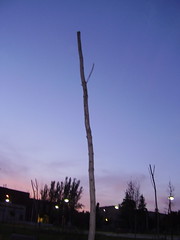new modes of storytelling
Of all the websites I explored this week, only Raid On Deerfield: The Many Stories of 1704 seems to have answered Steve Dietz's call for moving toward a kind of procedural authorship rather than object-centered exhibits. Dietz likens procedural authorship to baseball: "Every game, hundreds of thousands of them each year, is the same--set of rules. Yet every game is different. Each game has its own personality, based on the interactions of the players." Thus it is never like reading a book but it is still highly structured. The creators of the Deerfield website add to the idea of procedural authorship another layer: the lure of the story. Their approach is like nothing I've ever seen. They dramatize the stories of the many people involved in the raid. They also provide historical and cultural context, the usual timelines, songs, maps, and, of course, artifacts.
I felt myself drawn to the story menu more than anything else, because it was what I found truly novel. Songs, maps, artifacts, etc, with pop-up explanatory captions I'd seen before. But the story menu, with its five tabs for the different perspectives (English, French, Kanienkehaka, Wendat, Wôbanaki, along with the Overview), allows you to click on a reconstructed image of a scene along the timeline. Depending on the tab you choose, certain figures are highlighted. Then you click on the figure and read their story--a dramatized story, from their point of view. It is all very well-researched an footnoted appropriately, but like the scenes illustrating the progression of events before, during, and after the raid, they are informed reconstructions. Historical fiction. But it's so much better than a book or a film, because the medium allows for the tabs to show you all these interlocking points of view, so that there is no overarching narrative dictating what is important and what is not (of course, that too can function as an illusion -- it is laid out to be explored in a particular way). And it's engaging.
However, I wonder if a person would look through this site if they weren't either very much into history, or doing an assignment. I know I would. But the website feels a little clumsy at times (the link between entertainment and learning that can be a little stiff and forced at times). However, the possibilities it opens up are enormous. The authors of Less Clicking, More Watching emphasize that people tend to like "TV-like experiences where users watched experts and artists talk about art and culture, augmented by links to additional and in-depth information." Although the creators of the Deerfield website used a video to introduce the visitor to the site, they could have made more use of it in their creative reconstructions. They also could have linked songs and objects to the storylines. Regardless of these things, however, the site offers a compelling vision of where the web can take us as a radically different medium than text or film. This site could not have been recreated as a book or film. Object-centered sites, though interesting and "neat," just don't have the ability to pull us in the way clashing versions of an event does. It's the lure of the story. The creators of Raid on Deerfield seem to have caught on to that and begun an interesting negotiation between history, fiction, and image-making that will lead to interesting places.


0 Comments:
Post a Comment
<< Home